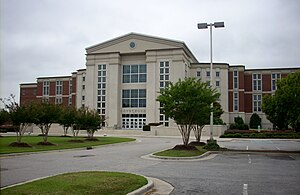County in North Carolina, United States
County in North Carolina
Harnett County ( HAR-nit)[1] is a county located in the U.S. state of North Carolina. As of the 2020 census, the population was 133,568.[2] Its county seat is Lillington;[3] its largest community is Anderson Creek.[4] Harnett County is part of the Anderson Creek, NC Micropolitan Statistical Area.[5]
History
Harnett County was formed in 1855 from land given by Cumberland County. It was named for American Revolutionary war soldier Cornelius Harnett,[6] who was also a delegate to the Continental Congress. The first settlers came to the region in the mid-1720s, and were followed by Highland Scots immigrants. The Scots settled in the foothills, where land was more affordable, rather than in the rich alluvial soil area of the coastal plain. After the defeat by the British of Bonny Prince Charles at Culloden, Scots immigrants came up the Cape Fear River in ever increasing numbers and settled in western Harnett County. British immigrants had settled primarily along the banks of the Cape Fear River in the coastal area, generally from Erwin to Wilmington.
During the American Revolutionary War, many of the Scots were Loyalists. In their defeat in Scotland, they had been forced to take ironclad vows that prohibited taking up arms against the British.[7] Some Rebels considered them traitors to the cause of Independence. Public executions of suspected spies occurred. One site near Lillington was the scene of a mass execution of "Scots traitors".[8]
Though Harnett County was not a site of warfare during the Civil War, one of the last battles took place near Averasborough, which was once the third-most populated town in North Carolina, but is no longer in existence. During the Carolinas Campaign, the Left Wing of General William Sherman's army under the command of Major General Henry W. Slocum defeated the army of General William Hardee in the Battle of Averasborough and proceeded eastward. A centennial celebration of the event was held in 1965 at the site of the battlefield.
Geography

Interactive map of Harnett County
According to the U.S. Census Bureau, the county has a total area of 601.22 square miles (1,557.2 km2), of which 594.93 square miles (1,540.9 km2) is land and 6.29 square miles (16.3 km2) (1.05%) is water.[9]
State and local protected areas/sites
Major water bodies
Adjacent counties
Major highways
Major infrastructure
Demographics
2020 census
As of the 2020 census, 133,568 people resided in the county, making it the 23rd most populous county in North Carolina. Anderson Creek was recorded as the largest community.[14][4]
Demographic change
| Historical population
|
Historical population
| Census | Pop. | Note | %± |
|---|
| 1860 | 8,039 | | — |
|---|
| 1870 | 8,895 | | 10.6% |
|---|
| 1880 | 10,862 | | 22.1% |
|---|
| 1890 | 13,700 | | 26.1% |
|---|
| 1900 | 15,988 | | 16.7% |
|---|
| 1910 | 22,174 | | 38.7% |
|---|
| 1920 | 28,313 | | 27.7% |
|---|
| 1930 | 37,911 | | 33.9% |
|---|
| 1940 | 44,239 | | 16.7% |
|---|
| 1950 | 47,605 | | 7.6% |
|---|
| 1960 | 48,236 | | 1.3% |
|---|
| 1970 | 49,667 | | 3.0% |
|---|
| 1980 | 59,570 | | 19.9% |
|---|
| 1990 | 67,822 | | 13.9% |
|---|
| 2000 | 91,025 | | 34.2% |
|---|
| 2010 | 114,678 | | 26.0% |
|---|
| 2020 | 133,568 | | 16.5% |
|---|
| 2023 (est.) | 141,477 | [2] | 5.9% |
|---|
|
|
Between 2010 and 2020, the population in Harnett County grew by 18,890 people, or 18.6 percent, though the largest city of Dunn (at the time) shrank by 4.8 percent during the same interval. Proportionately, the white population decreased by 6.7 percent, while the Hispanic/Latino population grew by 3.3 percent and the Asian population grew by 0.2 percent. The black and Native American populations remained about the same.[14]
Government and politics
Harnett is a typical "Solid South" county in its political history. Apart from the 1928 election when it defected to Herbert Hoover because of opposition to the Catholicism of Al Smith,[20] Harnett voted rock-solid Democratic until the 1960s when opposition to increasing liberalism on racial policies turned the electorate toward the segregationist candidacy of George Wallace. Since then apart from when carried twice by native Southerner Jimmy Carter in 1976 and 1980, Harnett has been a solidly Republican county.
United States presidential election results for Harnett County, North Carolina[21]
| Year
|
Republican
|
Democratic
|
Third party
|
| No. |
% |
No. |
% |
No. |
%
|
| 2020
|
35,177
|
60.35%
|
22,093
|
37.90%
|
1,023
|
1.75%
|
| 2016
|
27,614
|
59.95%
|
16,737
|
36.33%
|
1,714
|
3.72%
|
| 2012
|
25,565
|
58.89%
|
17,331
|
39.92%
|
519
|
1.20%
|
| 2008
|
23,579
|
57.93%
|
16,785
|
41.24%
|
341
|
0.84%
|
| 2004
|
20,922
|
64.24%
|
11,563
|
35.50%
|
86
|
0.26%
|
| 2000
|
14,762
|
61.08%
|
9,155
|
37.88%
|
250
|
1.03%
|
| 1996
|
11,596
|
53.34%
|
8,767
|
40.33%
|
1,376
|
6.33%
|
| 1992
|
9,751
|
46.58%
|
8,473
|
40.48%
|
2,708
|
12.94%
|
| 1988
|
9,749
|
57.25%
|
7,259
|
42.63%
|
21
|
0.12%
|
| 1984
|
11,198
|
61.11%
|
7,106
|
38.78%
|
19
|
0.10%
|
| 1980
|
7,284
|
44.70%
|
8,791
|
53.95%
|
220
|
1.35%
|
| 1976
|
5,935
|
39.61%
|
8,992
|
60.01%
|
58
|
0.39%
|
| 1972
|
10,259
|
74.64%
|
3,347
|
24.35%
|
138
|
1.00%
|
| 1968
|
5,184
|
32.97%
|
4,007
|
25.49%
|
6,531
|
41.54%
|
| 1964
|
5,883
|
44.03%
|
7,477
|
55.97%
|
0
|
0.00%
|
| 1960
|
5,301
|
40.18%
|
7,892
|
59.82%
|
0
|
0.00%
|
| 1956
|
3,998
|
35.01%
|
7,421
|
64.99%
|
0
|
0.00%
|
| 1952
|
4,306
|
36.18%
|
7,595
|
63.82%
|
0
|
0.00%
|
| 1948
|
1,985
|
22.26%
|
6,608
|
74.11%
|
323
|
3.62%
|
| 1944
|
3,191
|
32.66%
|
6,579
|
67.34%
|
0
|
0.00%
|
| 1940
|
2,280
|
25.67%
|
6,602
|
74.33%
|
0
|
0.00%
|
| 1936
|
2,264
|
22.02%
|
8,018
|
77.98%
|
0
|
0.00%
|
| 1932
|
2,617
|
29.04%
|
6,346
|
70.42%
|
49
|
0.54%
|
| 1928
|
4,740
|
57.15%
|
3,554
|
42.85%
|
0
|
0.00%
|
| 1924
|
2,895
|
46.68%
|
3,296
|
53.14%
|
11
|
0.18%
|
| 1920
|
3,311
|
45.80%
|
3,919
|
54.20%
|
0
|
0.00%
|
| 1916
|
1,603
|
44.49%
|
1,992
|
55.29%
|
8
|
0.22%
|
| 1912
|
148
|
5.80%
|
1,364
|
53.43%
|
1,041
|
40.78%
|
| 1908
|
1,047
|
41.01%
|
1,501
|
58.79%
|
5
|
0.20%
|
| 1904
|
723
|
37.60%
|
1,169
|
60.79%
|
31
|
1.61%
|
| 1900
|
1,199
|
47.17%
|
1,342
|
52.79%
|
1
|
0.04%
|
| 1896
|
1,042
|
37.95%
|
1,676
|
61.03%
|
28
|
1.02%
|
| 1892
|
650
|
25.87%
|
1,222
|
48.63%
|
641
|
25.51%
|
| 1888
|
1,100
|
42.34%
|
1,498
|
57.66%
|
0
|
0.00%
|
| 1884
|
744
|
37.24%
|
1,254
|
62.76%
|
0
|
0.00%
|
| 1880
|
704
|
40.65%
|
1,028
|
59.35%
|
0
|
0.00%
|
Harnett County is a member of the regional Mid-Carolina Council of Governments.
Education
Harnett County is home to Campbell University and to 27 other different schools: 4 primary schools, 13 elementary schools, 5 middle schools, 4 high schools, and 1 alternative school.[22][23]
Harnett County Schools is the local public school district.
Schools in the county include:
- Primary: Anderson Creek, Gentry, Harnett, North Harnett
- Elementary: Angier, Benhaven, Boone Trail, Buies Creek, Coats, Erwin, Highland, Johnsonville, LaFayette, Lillington-Shawtown, Overhills, South Harnett, Wayne Avenue
- Middle: Coats-Erwin, Dunn, Harnett Central, Highland, Overhills, Western Harnett
- High: Harnett Central, Overhills, Triton, Western Harnett
- Alternative: STAR Academy (grades 6–12)
- University: Campbell University
The Linden Oaks housing development, of Fort Liberty, has some Department of Defense Education Activity (DoDEA) schools, including Gary Ivan Gordon Elementary School,[24] Randall David Shughart Elementary School,[25] and Shugart Middle School.[26] High school students living in Linden Oaks are assigned to Harnett County Schools' Overhills High School.[27]
The county is served by the Harnett County Library System, based in Lillington with branches at Angier, Coats, Dunn, Erwin, Anderson Creek Primary School, and Boone Trail Community Center and Library.[28]









